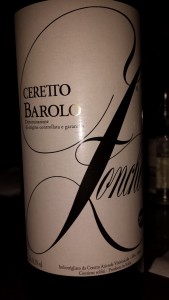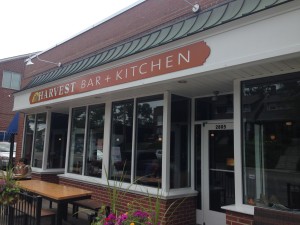 Often when I serve wine to friends, they ask where they might be able to buy it. Much of the wine I serve at home has been purchased direct from the winery or elsewhere and shipped or was purchased locally but in previous vintages and aged in my cellar. Most times, the wines I serve are not readily available here in central Ohio. That is why I was excited to write about a wine I had at a local restaurant here in Columbus.
Often when I serve wine to friends, they ask where they might be able to buy it. Much of the wine I serve at home has been purchased direct from the winery or elsewhere and shipped or was purchased locally but in previous vintages and aged in my cellar. Most times, the wines I serve are not readily available here in central Ohio. That is why I was excited to write about a wine I had at a local restaurant here in Columbus.
Harvest Bar and Kitchen in Clintonville does not, according to the bartender, have a substantial wine trade. It does, however, have a relatively extensive and interesting wine program, offering ten wines by the glass and 40 bottle selections including four sparkling, eleven white and 25 red wines. Harvest Kitchen advertises that it sells its wines by the bottle at $10 over state minimum, that is, above the minimum price required for retail sales by the State of Ohio, which is a very good deal by restaurant standards. The bottle price on their wine list tops out at $90 for a Pinot Noir from the Santa Lucia Highlands in California.
The wine list at Harvest Bar and Kitchen offers more information than many restaurants at this level, but less than one should find at a fine dining establishment with a more extensive and developed wine program. Nonetheless, the list does provide, in addition to the names of the producers and the wines, the country/state and region of origin and the varietal or varietals of grapes in the wine. One glaring omission is that it does not list the vintage; for that, you will have to ask.
So I did, and I ordered the 2009 Ceretto Barolo Zonchera, a red wine from northern Italy, on the list for $60.
I am very much a fan of Nebbiolo, the grape from which Barolo and Barbaresco are made. Nebbiolo is a native grape of the Piedmont region in northern Italy, where it has been cultivated for centuries. What I like about Nebbiolo is that it often produces wines with beautiful aromas of the forest floor and truffles, and that show significant acid and structure and big chewy tannins. In this manifestation Nebbiolo is not everyone’s cup of tea, to mix beverage metaphors, but it is certainly mine.
The Barolo Wars
Much has been written since the 1970s about the Barolo Wars, and my purpose here is not to give a detailed description of the often intra-familial battles that punctuate the struggle. My purpose is to explain how those arguments impact you as a wine drinker and the choices you make when faced with the task of selecting a wine. Piedmont, much like many other wine producing regions around the world, had a traditional style of both grape growing and wine making that was challenged by new generations of wine makers armed with an ever expanding knowledge of viticulture (the growing of grapes) and new techniques of viniculture (the making of wine).
The acidic, heavily tannic, traditionally-made Nebbiolo-based wines were not very approachable early on and so were aged in large, neutral wood barrels, chosen precisely because they would impart very little outside influence on the wine, which then needed a further long period of aging in bottle to allow the acids and tannins to soften. The modernist movement in Piedmont resulted in many changes in the vineyard and the winery aimed at improving quality, yes, but also intended to soften those sharp edges, making the wines accessible much earlier. The traditionalists believed that many of the new practices changed the very nature of the wine and abandoned what defined uniquely Piedmont wines.
The Judgment
Whether the traditional or modern style Barolo is “better” is certainly a matter of personal taste. Having tasted a lot of wines from both styles, I can say that both have benefited from quality enhancements over the last 30 years, and that I have had some truly remarkable wines produced in each of the styles. It is also the case that my personal taste runs to the more traditional style. I find the flavor profile and the big structure of those wines more to my liking. That personal preference notwithstanding, I thought the 2009 Ceretto Barolo Zonchera was quite appealing. This wine is approachable and drinking very nicely.
The Ceretto family would be considered modernists, and this wine clearly hails from that camp. It is aged for a year in French oak barriques, half new and half once-used, before spending an additional year in larger wooden casks. It has the classic Nebbiolo coloring, garnet fading to brick at the rim. The nose represents the more modernist style with hints of rose petal and strong sour cherry. After 30 minutes or so, there is vanilla on the nose as the new oak emerges. The acid, while evident, is well integrated as the sour cherry tones carry over to the palate. The finish is moderately long, and over time, the tannins emerge and firm up. No amount of modern styling can completely eliminate the extraordinary mouth feel of those Nebbiolo tannins. At 14.5 percent alcohol, I expected a little more of a burn than is evident here, so the alcohol is also well-integrated. This wine is a great match with smoked meats and so paired well with Harvest Bar and Kitchen’s Double Bacon pizza.
On the whole, this is a well-made, approachable, modern-styled Barolo well within its drinking window. I grade it as a strong B, or 88 points out of 100.

I love Barolo’s…… thanks for the tip
Well written, accessible, and interesting. A fun read
Makes me wish I still lived in Clintonville. Interesting read!